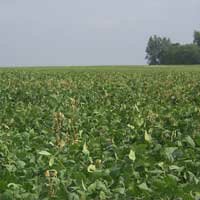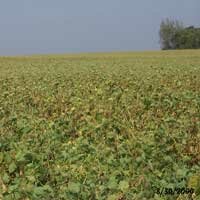
-
Soybean Diseases
- Asian Rust
- Anthracnose
- Bacterial Blight
- Bacterial Pustule
- Bean Pod Mottle Virus
- Brown Stem Rot
- Cercospora Leaf Blight
- Charcoal Rot
- Downy Mildew
- Frogeye Leaf Spot
- Green Stem Syndrome
- Iron Deficiency Chlorosis
- Phytophthora Root & Stem Rot
- Powdery Mildew
- Rhizoctonia
- Seedling Diseases
- Septoria (Brown Spot)
- SCN (Soybean Cyst Nematode)
- Soybean Mosaic Virus
- Stem Canker
- Sudden Death Syndrome
- Viruses
- White Mold
- Soybean Pests
- Diagnostic Help
- Field Trials
- Soybean Library
| Disease: Northern Stem Canker |
Your Soybean Checkoff.
Delivering Results.
Illinois
Indiana
Iowa
Kansas
Michigan
Minnesota
Missouri
Nebraska
North Dakota
Ohio
South Dakota
Wisconsin
Northern Stem Canker
Stem canker has been widely recognized as an important soybean disease, and has recently been divided into Northern stem canker and Southern stem canker based on two different pathogenic varieties of the fungus Diaporthe phaseolorum.
Northern stem canker caused serious yield losses (> 50%) on a widespread basis in the North Central region and Ontario in the 1950's. It was brought under control by shifting to new varieties, and has been a minor problem in the North Central region since then. Within the past ten years, however, an increase in the occurrence of Northern stem canker has been noted in Wisconsin, South Dakota, Minnesota and Iowa. In some cases individual fields have had disease incidences as high as 50%. The causes for the re-emergence of Northern stem canker are not known, but could include changes in the soybean varieties planted, as well as changes in farming practices.
Southern stem canker emerged as a problem in the southern soybean growing region in the 1970's. Epidemics were widespread and very high losses occurred. Southern stem canker is still a major factor impacting soybean production in the south.
There are similarities between symptoms of stem canker and other late season diseases, such as white mold or Phytophthora stem rot. Field symptoms of stem canker also look like early crop maturity. Because of these similarities, stem canker can be easily misdiagnosed. Growers and scouts should become familiar with and be able to distinguish among these late season diseases and conditions.
Agronomic impact
Northern stem canker is caused by Diaporthe phaseolorum var. caulivora , whereas Southern stem canker is caused by Diaporthe phaseolorum var. meridionalis. Both fungi are seed-borne and can cause reduced germination of infected seed. They can also cause seedling decay and mortality from soil-borne infection. A tip blight caused by stem canker fungi but that is distinct from typical stem canker symptoms has also been noted.
Economic loss from Northern stem canker is directly related to how early in the growing season the pathogen begins to actively grow and kill stem tissue. The pathogen produces toxins that are transported to foliar tissue, causing interveinal necrosis in the leaves. But the main damage is caused by lesions that girdle the stem, thereby preventing translocation of water from roots to leaves. Once stems are girdled, plants wilt and there is no further assimilation of photosynthate into developing seed.
Causal pathogens
The fungi causing stem canker are closely related to Diaporthe phaseolorum var. sojae (Phomopsis sojae), which causes Pod and stem blight of soybean, as well as to Phomopsis longicolla, which causes Phomopsis seed decay of soybeans. This group of fungi are part of what is called the Diaporthe/Phomopsis complex.
The two fungi causing stem canker differ in several characteristics such as cultural morphology, symptomology, pathogenicity on specific soybean varieties, as well as optimum temperature growth in culture. Molecular diagnostic methods can be used to distinguish between them and other fungi inthe Diaporthe/Phomopsis complex.
Contributed by , Department of Plant Science, South Dakota State University



